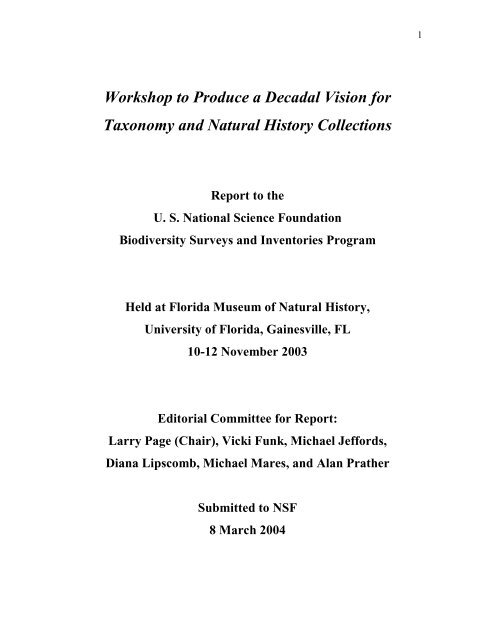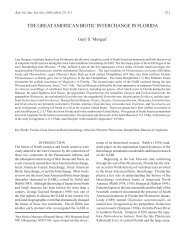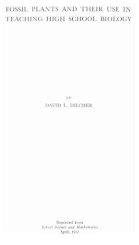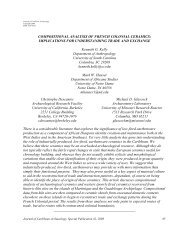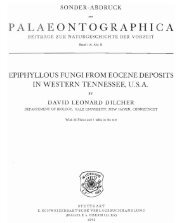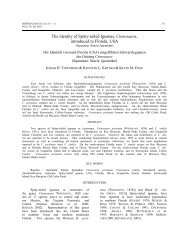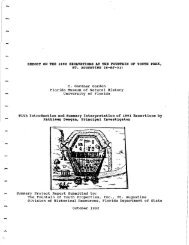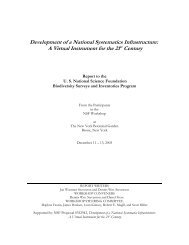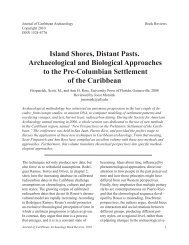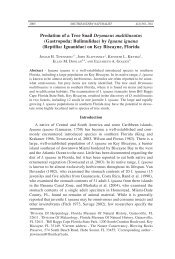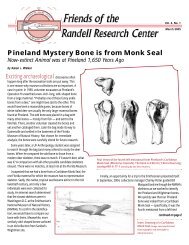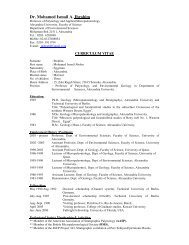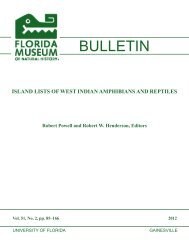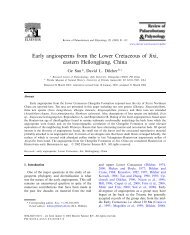Workshop to Produce a Decadal Vision for Taxonomy and Natural ...
Workshop to Produce a Decadal Vision for Taxonomy and Natural ...
Workshop to Produce a Decadal Vision for Taxonomy and Natural ...
Create successful ePaper yourself
Turn your PDF publications into a flip-book with our unique Google optimized e-Paper software.
<strong>Workshop</strong> <strong>to</strong> <strong>Produce</strong> a <strong>Decadal</strong> <strong>Vision</strong> <strong>for</strong><br />
<strong>Taxonomy</strong> <strong>and</strong> <strong>Natural</strong> His<strong>to</strong>ry Collections<br />
Report <strong>to</strong> the<br />
U. S. National Science Foundation<br />
Biodiversity Surveys <strong>and</strong> Inven<strong>to</strong>ries Program<br />
Held at Florida Museum of <strong>Natural</strong> His<strong>to</strong>ry,<br />
University of Florida, Gainesville, FL<br />
10-12 November 2003<br />
Edi<strong>to</strong>rial Committee <strong>for</strong> Report:<br />
Larry Page (Chair), Vicki Funk, Michael Jef<strong>for</strong>ds,<br />
Diana Lipscomb, Michael Mares, <strong>and</strong> Alan Prather<br />
Submitted <strong>to</strong> NSF<br />
8 March 2004<br />
1
Introduction<br />
Fifty-nine representatives from 48 institutions <strong>and</strong> representing 31 scientific societies <strong>and</strong><br />
agencies (Appendix I) met in Gainesville, FL, on 10-12 November 2003 <strong>to</strong> consider the<br />
future of taxonomy <strong>and</strong> natural his<strong>to</strong>ry collections in the United States. The workshop<br />
was funded by the Biodiversity Surveys <strong>and</strong> Inven<strong>to</strong>ries Program of the Division of<br />
Environmental Biology of the U.S. National Science Foundation <strong>and</strong> hosted by the<br />
Florida Museum of <strong>Natural</strong> His<strong>to</strong>ry. Most of the 59 participants were nominated by<br />
presidents of taxon-oriented societies; this strategy diversified the attendance beyond that<br />
which would be selected by a small group of workshop organizers. Additional<br />
participants were selected <strong>to</strong> increase the geographic, demographic <strong>and</strong> institutional<br />
diversity, as well as the taxonomic expertise of attendees. In addition <strong>to</strong> the workshop<br />
participants, about 30 students, faculty, <strong>and</strong> employees from the University of Florida<br />
attended as observers.<br />
The <strong>for</strong>mat of the workshop consisted of seven presentations <strong>to</strong> review the goals<br />
of the workshop <strong>and</strong> other relevant <strong>to</strong>pics followed by a series of breakout sessions <strong>to</strong><br />
address specific questions. After each breakout, the participants returned <strong>to</strong> the main<br />
meeting room <strong>and</strong> summarized their discussions. On the last day of the workshop,<br />
recommendations were agreed upon <strong>and</strong> an implementation strategy was developed.<br />
Why the <strong>Workshop</strong> was Needed<br />
Although thous<strong>and</strong>s of taxonomists belong <strong>to</strong> taxon-focused societies, <strong>and</strong> many<br />
work at institutions with natural his<strong>to</strong>ry collections, they have had little influence on the<br />
priorities of the national research agenda in the biological sciences. Throughout the U.S.,<br />
many natural his<strong>to</strong>ry collections are being <strong>for</strong>ced <strong>to</strong> scale back their programs or, in<br />
extreme cases, close their doors (Black, 1984; Tirrell, 2001). Some of these cuts are<br />
attributable <strong>to</strong> short-term fiscal crises, but others appear <strong>to</strong> be the result of administra<strong>to</strong>rs<br />
moving away from natural his<strong>to</strong>ry <strong>and</strong> organismal biology (Gropp, 2003; Suarez <strong>and</strong><br />
Tsutsui, 2004).<br />
<strong>Natural</strong> his<strong>to</strong>ry collections are facing serious financial challenges in spite of the<br />
conclusions of several important <strong>and</strong> widely circulated reports that the results of<br />
taxonomic <strong>and</strong> systematic research are fundamental <strong>to</strong> addressing many scientific <strong>and</strong><br />
societal needs, including the development of strategies <strong>for</strong> countering the loss of<br />
biodiversity (e.g., National Science Board, 1989; Systematics Agenda 2000, 1994).<br />
Other recent workshops <strong>and</strong> publications recognized major research questions that<br />
must be addressed <strong>and</strong> identified important societal benefits that accrue with knowledge<br />
resulting from taxonomic research <strong>and</strong> natural his<strong>to</strong>ry collections. For example,<br />
Systematics Agenda 2000 (Claridge, 1995) clearly articulated the core missions of<br />
taxonomy (<strong>to</strong> inven<strong>to</strong>ry the species diversity of the globe, <strong>to</strong> produce a predictive<br />
classification of life, <strong>and</strong> <strong>to</strong> organize this in<strong>for</strong>mation in<strong>to</strong> an efficiently retrievable <strong>for</strong>m).<br />
However, these sources rarely emphasized the fundamental connection between<br />
taxonomic research <strong>and</strong> natural his<strong>to</strong>ry collections.<br />
It is incumbent upon organismal biologists, <strong>and</strong> systematists in particular, <strong>to</strong><br />
speak with a unified <strong>and</strong> effective voice in explaining the value of taxonomy <strong>and</strong><br />
biological collections in documenting the his<strong>to</strong>ry <strong>and</strong> health of the planet <strong>and</strong> in<br />
protecting <strong>and</strong> managing biological resources. With environmental deterioration<br />
proceeding rapidly, little time remains <strong>for</strong> documenting the world’s biodiversity, <strong>and</strong><br />
taxonomy <strong>and</strong> natural his<strong>to</strong>ry collections remain the core resources <strong>for</strong> accomplishing<br />
this extremely important task. Most work on species-level taxonomy is necessarily<br />
specimen-based <strong>and</strong> is likely <strong>to</strong> remain that way. Collections of specimens are necessary<br />
<strong>for</strong> the fulfillment of the research <strong>and</strong> societal benefits identified below.<br />
2
Goals <strong>and</strong> Topics Addressed<br />
The goals of the workshop were <strong>to</strong>:<br />
(a) Identify the major research questions that must be addressed with knowledge resulting<br />
from taxonomic research <strong>and</strong> natural his<strong>to</strong>ry collections.<br />
(b) Identify important societal benefits that accrue from taxonomic research <strong>and</strong> natural<br />
his<strong>to</strong>ry collections.<br />
(c) <strong>Produce</strong> a 10-year vision <strong>for</strong> taxonomy <strong>and</strong> natural his<strong>to</strong>ry collections, <strong>and</strong> develop a<br />
plan <strong>to</strong> meet the priorities of that vision.<br />
(d) Communicate the results <strong>and</strong> recommendations of the workshop participants <strong>to</strong><br />
scientists, administra<strong>to</strong>rs, <strong>and</strong> policy makers.<br />
(e) Consider the utility of an ad-hoc overarching umbrella organization in providing an<br />
effective voice <strong>for</strong> the taxonomic community <strong>and</strong> in facilitating <strong>and</strong> moni<strong>to</strong>ring progress<br />
on recommendations made by participants of the workshop.<br />
Results<br />
The principal conclusions of the workshop emphasized the importance of natural<br />
his<strong>to</strong>ry collections <strong>to</strong> science <strong>and</strong> society:<br />
1. <strong>Natural</strong> his<strong>to</strong>ry collections contain a vast amount of biological in<strong>for</strong>mation that<br />
exists in no other <strong>for</strong>m or place <strong>and</strong> that cost the nation billions of dollars <strong>and</strong><br />
centuries of ef<strong>for</strong>t <strong>to</strong> amass. The U.S. holds by far the greatest number of natural<br />
his<strong>to</strong>ry collections of any country in the world.<br />
2. Many of the specimens <strong>and</strong> ancillary data in collections were obtained prior <strong>to</strong><br />
major modifications of the l<strong>and</strong>scape that have characterized modern<br />
development <strong>and</strong>, consequently, are an irreplaceable record of our natural<br />
heritage. This in<strong>for</strong>mation is fundamental <strong>to</strong> underst<strong>and</strong>ing the natural <strong>and</strong><br />
cultural his<strong>to</strong>ry of our nation <strong>and</strong> the world <strong>and</strong>, as such must be maintained in<br />
perpetuity.<br />
3. The in<strong>for</strong>mation needed <strong>to</strong> accomplish major scientific goals <strong>and</strong> provide<br />
important societal benefits (identified below) is contained in natural his<strong>to</strong>ry<br />
collections. These goals <strong>and</strong> benefits are unrealized because natural his<strong>to</strong>ry<br />
collections are not managed (or even properly recognized) as a national resource.<br />
4. The solution <strong>to</strong> the unrealized potential of natural his<strong>to</strong>ry collections is <strong>to</strong> view<br />
them as a single entity, i.e., as a network of biological observa<strong>to</strong>ries distributed<br />
across the nation <strong>and</strong> with a database that is continually increasing in quantity,<br />
quality, <strong>and</strong> scientific value; hereafter referred <strong>to</strong> as LINNE = Legacy<br />
Infrastructure Network <strong>for</strong> <strong>Natural</strong> Environments.<br />
Creating an interactive <strong>and</strong> linked network of biological observa<strong>to</strong>ries will<br />
substantially increase the amount of available in<strong>for</strong>mation on the geographic <strong>and</strong><br />
temporal distributions of organisms <strong>and</strong> significantly enhance the ability of<br />
taxonomists <strong>to</strong> identify <strong>and</strong> describe species, <strong>and</strong> of phylogeneticists <strong>to</strong> ascertain<br />
relationships among species. As better taxonomic <strong>and</strong> phylogenetic in<strong>for</strong>mation<br />
becomes available, the scientific community will be better able <strong>to</strong>:<br />
1. Conduct research on environmental issues such as human health, climate change,<br />
<strong>and</strong> invasive species.<br />
2. Improve our underst<strong>and</strong>ing of the his<strong>to</strong>ry of life <strong>and</strong> our ability <strong>to</strong> address<br />
questions in comparative biology such as those related <strong>to</strong> the origin <strong>and</strong><br />
maintenance of clades <strong>and</strong> biogeographic patterns, <strong>and</strong> the evolution of infectious<br />
diseases.<br />
3. Recognize important new areas of scientific research such as those related <strong>to</strong><br />
biosecurity <strong>and</strong> biotechnology.<br />
3
4. Provide in<strong>for</strong>mation instantly on species distributions, species associations,<br />
habitat preferences, <strong>and</strong> other data required by ecologists <strong>and</strong> conservationists,<br />
<strong>and</strong> by public health workers attempting <strong>to</strong> respond effectively <strong>to</strong> emerging<br />
human pathogens.<br />
Creation of LINNE<br />
The United States currently is unable <strong>to</strong> realize certain scientific <strong>and</strong> societal<br />
benefits because natural his<strong>to</strong>ry collections—the reposi<strong>to</strong>ries of the fundamental data of<br />
nature—are underfunded, understaffed, <strong>and</strong> underutilized. This situation exists because<br />
collections are maintained <strong>and</strong> managed as separate institutional properties, where each<br />
collection has only a small role <strong>to</strong> play in scientific investigation, <strong>and</strong> where data are<br />
difficult <strong>to</strong> extract <strong>and</strong> manage. Instead, natural his<strong>to</strong>ry collections must be recognized as<br />
unique sources of significant scientific data <strong>and</strong> their full potential will only be realized<br />
when they are managed as components of one vast network of in<strong>for</strong>mation (LINNE).<br />
When the natural his<strong>to</strong>ry collections of the nation are linked <strong>to</strong>gether in an interactive<br />
system <strong>and</strong> managed as one large <strong>and</strong> easily accessed source of biological data, science<br />
<strong>and</strong> society will be able <strong>to</strong> move <strong>for</strong>ward in a much more productive, expeditious, <strong>and</strong><br />
efficient manner. A particularly significant result of LINNE will be that research will be<br />
able <strong>to</strong> be conducted on a national or continental scale rather than on smaller <strong>and</strong> less<br />
scientifically significant geographic areas as now often is done.<br />
Most of the infrastructure necessary <strong>to</strong> create LINNE is in place in the <strong>for</strong>m of<br />
natural his<strong>to</strong>ry collections housed in universities <strong>and</strong> museums. This system of<br />
collections, the foundation <strong>for</strong> LINNE, is distributed throughout the U.S., with several<br />
nodes located in every state. This vast national collection resource has been built with<br />
private <strong>and</strong> public funds over a period of almost 200 years at an enormous cost.<br />
Although the basic infrastructure <strong>for</strong> LINNE is in place, the in<strong>for</strong>mation in<br />
collections is often largely unavailable, even <strong>to</strong> researchers. Herculean ef<strong>for</strong>ts are<br />
required <strong>for</strong> individuals <strong>to</strong> extract in<strong>for</strong>mation from the many collections where data are<br />
not available in electronic <strong>for</strong>m. Some collections have not even received sufficient<br />
cura<strong>to</strong>rial attention <strong>to</strong> be readily accessible. Attention <strong>to</strong> the following areas is necessary<br />
<strong>to</strong> maximize the availability of in<strong>for</strong>mation <strong>and</strong> fully realize the potential of LINNE.<br />
1. Modernize collection facilities. To maximize the usefulness of natural<br />
his<strong>to</strong>ry collections, ancillary collections (such as libraries, pho<strong>to</strong>graphs, digital images,<br />
plant <strong>and</strong> animal tissues, <strong>and</strong> field notes), <strong>and</strong> associated databases <strong>and</strong> <strong>to</strong> guarantee their<br />
long-term survival, funds are necessary <strong>for</strong> the improvement of collection facilities across<br />
the nation <strong>and</strong> <strong>for</strong> technical assistance <strong>to</strong> manage the facilities. Although the emphasis<br />
<strong>to</strong>day often is on “in<strong>for</strong>mation transfer” <strong>and</strong> electronic databases, specimens always<br />
harbor much more data than can be displayed electronically. It is thus vital <strong>to</strong> emphasize<br />
the source of in<strong>for</strong>mation – the specimens themselves - <strong>and</strong> not just currently available<br />
data. Examples of the needs <strong>for</strong> collections include better <strong>and</strong> safer s<strong>to</strong>rage facilities that<br />
meet OSHA <strong>and</strong> International Fire Code requirements (fire-resistant cabinets, spacesaving<br />
compac<strong>to</strong>rs, etc.), replacement of poor s<strong>to</strong>rage media (diluted or improper<br />
preservatives, non-acid free herbarium sheets, etc.) <strong>and</strong> deteriorating labels with archival<br />
quality labels, <strong>and</strong> more collection managers <strong>and</strong> technicians <strong>to</strong> care <strong>for</strong> collections,<br />
catalog specimens, <strong>and</strong> database locality <strong>and</strong> other specimen data. Ancillary collections<br />
such as pho<strong>to</strong>graphic slides <strong>and</strong> film, digital images, plant <strong>and</strong> animal tissue collected <strong>for</strong><br />
DNA research, field notebooks, libraries, etc. also have <strong>to</strong> be included in any plan.<br />
Collection management must emphasize conservation of materials (Rose <strong>and</strong> Hawks,<br />
1995). In addition <strong>to</strong> an initial infusion of funds <strong>to</strong> improve collection facilities <strong>and</strong><br />
staffing needs, the annual budget of NSF’s Biological Research Collections Program<br />
(BRC) should be increased <strong>to</strong> $20 million as soon as possible. This increase is necessary<br />
<strong>to</strong> reverse the situation of inadequate housing <strong>and</strong> staffing <strong>for</strong> the nation’s natural his<strong>to</strong>ry<br />
4
collections that ultimately will lead <strong>to</strong> their loss or that will continue <strong>to</strong> make these<br />
resources only minimally accessible. The program also should more strongly encourage<br />
research on improved methods <strong>for</strong> long-term s<strong>to</strong>rage of specimens <strong>and</strong> ancillary<br />
collections. Increasing the budget of BRC sustains the process of peer-review in<br />
identifying the most critical areas <strong>for</strong> new federal investment in natural science<br />
collections.<br />
2. Update <strong>and</strong> verify specimen identifications. Accurate identification of<br />
specimens in natural his<strong>to</strong>ry collections is necessary <strong>for</strong> all research related <strong>to</strong> the spatial<br />
<strong>and</strong> temporal distributions of organisms. Misidentified specimens can lead <strong>to</strong><br />
misin<strong>for</strong>med <strong>and</strong> inaccurate recommendations on endangered species, invasive species,<br />
human disease vec<strong>to</strong>rs, agents of bioterrorism, <strong>and</strong> other matters important <strong>to</strong> national<br />
security or scientific efficiency. Because of the insufficient number of taxonomists in the<br />
U.S. <strong>and</strong> around the world, many specimens in museums now are unidentified or<br />
incorrectly identified (estimates by workshop participants of misidentified specimens<br />
were 10-60% depending on the taxonomic group). This dire situation exists because <strong>to</strong>o<br />
few taxonomists are available <strong>to</strong> identify specimens <strong>and</strong> keep names up <strong>to</strong> date as new<br />
descriptions appear. Funds must be made available <strong>to</strong> enable taxonomists <strong>to</strong> visit<br />
collections <strong>and</strong> update specimen identifications, <strong>and</strong> <strong>to</strong> train new taxonomists as experts<br />
on groups of organisms <strong>for</strong> which insufficient expertise exists. The failure of support <strong>for</strong><br />
taxonomy <strong>to</strong> keep pace with the growing need <strong>for</strong> credible taxonomic in<strong>for</strong>mation<br />
impedes our ability <strong>to</strong> conserve, manage, <strong>and</strong> underst<strong>and</strong> the natural world (Wheeler et<br />
al., 2004).<br />
3. Exp<strong>and</strong> the electronic availability of data. The great proportion of the<br />
taxonomic, geographic <strong>and</strong> other in<strong>for</strong>mation available on specimens in collections<br />
remains non-databased <strong>and</strong> unavailable <strong>to</strong> researchers <strong>and</strong> educa<strong>to</strong>rs. Publications based<br />
on data extracted from these specimens provide an important source of in<strong>for</strong>mation <strong>to</strong><br />
science <strong>and</strong> society, but only a fraction of the <strong>to</strong>tal amount of in<strong>for</strong>mation available from<br />
the millions of specimens <strong>and</strong> associated data residing in institutional collections can be<br />
readily utilized at present. Additional in<strong>for</strong>mation needs <strong>to</strong> be databased, <strong>and</strong> all possible<br />
in<strong>for</strong>mation must be made readily available on the internet. The nation’s collections<br />
represent the most underutilized scientific resource in existence.<br />
[A workshop entitled, “Development of a National Systematics Infrastructure: A<br />
Virtual Instrument <strong>for</strong> the 21 st Century,” was held at the New York Botanical Garden on<br />
11-13 December 2003, <strong>to</strong> address the cyberinfrastructure necessary <strong>for</strong> the efficient<br />
distribution of data from natural his<strong>to</strong>ry collections <strong>and</strong> other taxonomically relevant<br />
data. This <strong>to</strong>pic was not specifically addressed at the Florida workshop.]<br />
Recent Initiatives at NSF<br />
Participants of the workshop unanimously expressed strong support <strong>for</strong> recent initiatives<br />
at NSF that enhance our nation’s taxonomic expertise <strong>and</strong> our knowledge of biodiversity,<br />
including:<br />
• Partnerships <strong>for</strong> Enhancing Expertise in <strong>Taxonomy</strong> (PEET)<br />
• Planetary Biodiversity Inven<strong>to</strong>ries (PBI)<br />
• Revisionary Syntheses in Systematics (RevSys)<br />
• Assembling the Tree of Life (AToL)<br />
These initiatives support student training, public outreach, <strong>and</strong> collecting,<br />
vouchering, <strong>and</strong> describing species-level diversity, as well as deciphering phylogenetic<br />
relationships of all <strong>for</strong>ms of life on Earth, from microbes <strong>to</strong> mammals. Collectively, they<br />
encourage <strong>and</strong> support expeditionary work <strong>to</strong> document biotic diversity in poorly known<br />
environments <strong>and</strong>, by doing so, represent an extremely timely <strong>and</strong> important response by<br />
NSF <strong>to</strong> the biodiversity crisis <strong>and</strong> the scientific community’s concern about the urgent<br />
5
need <strong>to</strong> document our natural heritage. Habitats are being lost, species are going extinct<br />
at an unprecedented rate, <strong>and</strong> the time remaining <strong>to</strong> document the biodiversity of our<br />
planet is very short. As the l<strong>and</strong>scape of the United States, <strong>and</strong> that of much of the world,<br />
undergoes massive change, documentation of the impact of this change resides in<br />
collections built through projects supported in large part by programs of the National<br />
Science Foundation. Documentation of Earth’s biological diversity must be completed in<br />
the next few decades or much of the products of billions of years of evolution will<br />
disappear without being recorded or analyzed. Lost with that diversity will be not only<br />
the his<strong>to</strong>ry of our biological world, but also a multitude of opportunities <strong>to</strong> develop new<br />
foods, medicines, biocontrol strategies <strong>for</strong> pests, <strong>and</strong> other products that benefit humans.<br />
It is imperative that these initiatives continue <strong>and</strong> be exp<strong>and</strong>ed <strong>to</strong> the fullest extent<br />
possible if we are <strong>to</strong> meet the challenges of the biodiversity crisis <strong>and</strong> realize societal<br />
benefits. <strong>Workshop</strong> participants strongly recommend that these initiatives achieve<br />
permanent status at NSF comparable <strong>to</strong> that of Systematic Biology, Long-Term<br />
Ecological Research, <strong>and</strong> other major programs. Given the urgency of discovering<br />
<strong>and</strong> describing our disappearing biodiversity, funding <strong>for</strong> these initiatives should be<br />
increased immediately <strong>to</strong> the fullest extent possible.<br />
Biological Research Collections Program<br />
Un<strong>for</strong>tunately, in contrast <strong>to</strong> the response by NSF <strong>to</strong> document the biodiversity of<br />
the planet by supporting taxonomic research <strong>and</strong> fieldwork, NSF’s Biological Research<br />
Collections Program (BRC) has had a flat annual budget of ca. $6 million <strong>for</strong> over 10<br />
years. This situation exists in spite of the fact that the success of the new taxonomic<br />
initiatives at NSF is resulting in the annual addition of very large numbers of specimens<br />
<strong>to</strong> natural his<strong>to</strong>ry collections. BRC is the only federal program supporting natural his<strong>to</strong>ry<br />
collections, <strong>and</strong> its budget is a fraction of the <strong>to</strong>tal amount needed <strong>to</strong> properly house <strong>and</strong><br />
care <strong>for</strong> the irreplaceable specimens <strong>and</strong> databases. <strong>Workshop</strong> participants strongly<br />
recommend that the annual budget of BRC be increased <strong>to</strong> $20 million. A budget of<br />
this amount will stimulate the scientific community <strong>to</strong> seriously consider the long-term<br />
needs of the nation in terms of collection-oriented education <strong>and</strong> research <strong>and</strong> <strong>to</strong> begin <strong>to</strong><br />
address the problems of maintaining these collections in perpetuity. The present budget<br />
of BRC is <strong>to</strong>o small <strong>to</strong> stimulate this kind of national response.<br />
In addition, workshop participants recommend that BRC consider making small<br />
awards <strong>to</strong> institutions with collections <strong>to</strong> enable retirees <strong>to</strong> continue their taxonomic<br />
studies. Often, a retiree is one of only a few individuals with the taxonomic expertise<br />
required <strong>to</strong> make accurate identifications or complete monographs on poorly known<br />
groups of species. With small amounts of funding, perhaps only a few thous<strong>and</strong> dollars,<br />
these individuals can continue <strong>to</strong> make large contributions <strong>to</strong> our underst<strong>and</strong>ing of<br />
biodiversity.<br />
A 10-Year <strong>Vision</strong> <strong>for</strong> <strong>Taxonomy</strong> <strong>and</strong> <strong>Natural</strong> His<strong>to</strong>ry Collections<br />
The steps outlined above require a substantial infusion of funds that is only likely<br />
<strong>to</strong> come from the federal government. However, the benefits <strong>to</strong> science <strong>and</strong> society will<br />
quickly justify the costs. In<strong>for</strong>mation that is already in databases around the country can<br />
be networked within a year <strong>and</strong>, with adequate funding, LINNE will be fully functional<br />
within a decade.<br />
With implementation of the steps outlined above <strong>to</strong> strengthen <strong>and</strong> improve<br />
the state of taxonomy <strong>and</strong> natural his<strong>to</strong>ry collections, significant progress in<br />
answering the following major research questions will be realized within the next<br />
decade:<br />
1. What are the characteristics of biological diversity on Earth?<br />
6
• How many species are there?<br />
• How are species distributed on the planet, <strong>and</strong> why are they distributed as<br />
they are?<br />
• How do species vary, <strong>and</strong> what his<strong>to</strong>rical <strong>and</strong> ecological fac<strong>to</strong>rs are<br />
responsible <strong>for</strong> the variation?<br />
• How do sets of species covary across the habitats of the world <strong>and</strong> how do<br />
such species sets respond <strong>to</strong> environmental perturbations?<br />
2. What is the his<strong>to</strong>ry of life on Earth?<br />
• How are species interrelated genetically?<br />
• How has biological diversification taken place through space <strong>and</strong> time?<br />
• What environmental fac<strong>to</strong>rs lead <strong>to</strong> speciation, dispersal, <strong>and</strong> extinction?<br />
These research questions overlap the six environmental challenges identified <strong>for</strong><br />
NEON [National Ecological Observa<strong>to</strong>ry Network] by the National Research Council<br />
<strong>and</strong> <strong>for</strong> which “a NEON-like national network of infrastructure would be essential <strong>for</strong><br />
their solution” (National Research Council, 2004).<br />
1. Biodiversity, species composition, <strong>and</strong> ecosystem functioning.<br />
2. Ecological aspects of biogeochemical cycles.<br />
3. Ecological implications of climate change.<br />
4. Ecology <strong>and</strong> evolution of infectious diseases.<br />
5. Invasive species.<br />
6. L<strong>and</strong> use <strong>and</strong> habitat alteration.<br />
Effectively addressing these environmental challenges requires accurate species<br />
identification <strong>and</strong> long-term in<strong>for</strong>mation on the spatial <strong>and</strong> temporal distributions of<br />
organisms. Such in<strong>for</strong>mation is generated only through taxonomic <strong>and</strong> phylogenetic<br />
research, <strong>and</strong> from natural his<strong>to</strong>ry collection databases. However, because natural his<strong>to</strong>ry<br />
collections are not managed as a coordinated national resource, this in<strong>for</strong>mation now is<br />
only partially available <strong>and</strong> difficult <strong>to</strong> obtain. In the opinion of workshop<br />
participants, LINNE is required <strong>for</strong> the success of NEON. If organisms cannot be<br />
identified correctly, all subsequent research is suspect.<br />
Important societal benefits that accrue from taxonomic research <strong>and</strong> natural<br />
his<strong>to</strong>ry collections <strong>and</strong> that will be facilitated by LINNE include the following.<br />
Several fall in<strong>to</strong> the category of improved bio<strong>for</strong>ecasting; i.e., LINNE will enhance<br />
our ability <strong>to</strong> predict which organisms might be used by terrorists or that pose a<br />
significant threat <strong>to</strong> agriculture. LINNE also will improve our ability <strong>to</strong> <strong>for</strong>ecast the<br />
impacts of climate change or extinction of particular species on natural or<br />
agricultural ecosystems.<br />
1. Education: Source materials <strong>for</strong> classroom instruction <strong>and</strong> outreach programs,<br />
including images <strong>and</strong> published in<strong>for</strong>mation, will become readily available - principally<br />
in electronic <strong>for</strong>m. These materials will in turn enhance/res<strong>to</strong>re organism-based<br />
instruction as well as offer new pedagogic opportunities such as the ability of students <strong>to</strong><br />
readily test hypotheses with large sets of collection data.<br />
2. <strong>Natural</strong> resource management: Improved in<strong>for</strong>mation on biodiversity will<br />
enhance the ability of conservationists <strong>and</strong> resource managers <strong>to</strong> identify areas of high<br />
species diversity, high endemism, <strong>and</strong> exploitable resources, <strong>and</strong> improve ef<strong>for</strong>ts at<br />
protecting <strong>and</strong> managing natural resources.<br />
3. Biosecurity: A wide array of species could be used <strong>to</strong> disrupt the economy <strong>and</strong><br />
health systems of the United States, <strong>and</strong> the identification of organisms used, or having a<br />
potential use, by terrorists can be difficult. Species identification requires taxonomic<br />
expertise <strong>and</strong> in<strong>for</strong>mation on diagnostic traits <strong>and</strong> geographic distributions of related<br />
7
organisms. This in<strong>for</strong>mation is s<strong>to</strong>red in biological collections, although it presently<br />
cannot be obtained in a quick or efficient manner. Responses <strong>to</strong> possible bioterrorism<br />
threats must be swift. LINNE will cut the time <strong>to</strong> access data from years <strong>to</strong> minutes or<br />
hours. Seldom has it been possible <strong>to</strong> have such a profound <strong>and</strong> positive influence on the<br />
accessibility of a scientific resource database that is vital <strong>to</strong> the nation’s security.<br />
4. Our natural heritage: <strong>Natural</strong> his<strong>to</strong>ry collections contain a unique <strong>and</strong><br />
irreplaceable record of the natural <strong>and</strong> cultural his<strong>to</strong>ry of our nation. Many of the<br />
specimens <strong>and</strong> ancillary data in collections were obtained prior <strong>to</strong> the major<br />
modifications of the l<strong>and</strong>scape that have characterized the development of the United<br />
States <strong>and</strong> are irreplaceable. Indeed, the collections are the fundamental database on the<br />
changing l<strong>and</strong>scapes <strong>and</strong> patterns of species distributions of the nation. It is important<br />
that this record be preserved in perpetuity.<br />
5. Invasive species: Preventing invasions by noxious species <strong>and</strong> predicting the<br />
impacts of those already in the U.S. require accurate identifications of specimens <strong>and</strong><br />
in<strong>for</strong>mation on the natural distributions <strong>and</strong> ecological requirements of targeted species<br />
<strong>and</strong> with associated species that may interact, either positively or negatively, with the<br />
invading species. Invasive species can decrease l<strong>and</strong> values dramatically in some cases<br />
<strong>and</strong> otherwise degrade the value of property. Interception of potential agricultural, <strong>for</strong>est<br />
or medical pest species at U.S. borders will be greatly facilitated by access <strong>to</strong> a<br />
distributed network of taxonomic resources<br />
6. Agriculture <strong>and</strong> medicine. Management of pests of food, <strong>for</strong>est, fiber, <strong>and</strong><br />
industrial crops; use of organisms as natural or biological control agents of pests; <strong>and</strong><br />
management <strong>and</strong> control of vec<strong>to</strong>rs of diseases of humans, lives<strong>to</strong>ck, <strong>and</strong> plants are all<br />
critically dependent upon accurate <strong>and</strong> timely species identifications <strong>and</strong> the in<strong>for</strong>mation<br />
contained in natural his<strong>to</strong>ry collections.<br />
7. Bioprospecting: Successful identification of new pharmaceuticals, foods, <strong>and</strong><br />
other as yet-undiscovered uses <strong>for</strong> organisms requires taxonomic <strong>and</strong> phylogenetic<br />
research, <strong>and</strong> distributional in<strong>for</strong>mation from natural his<strong>to</strong>ry collections. Only natural<br />
his<strong>to</strong>ry collections permit the correct identification <strong>and</strong> an underst<strong>and</strong>ing of the<br />
distribution of new species, any of which could provide an important new genetic or<br />
economic resource <strong>to</strong> humanity.<br />
8. Forensic science: Forensic science is based on pro<strong>to</strong>cols that require accurate<br />
identifications of organisms <strong>and</strong> distributional in<strong>for</strong>mation from natural his<strong>to</strong>ry<br />
collections.<br />
9. His<strong>to</strong>ry of science: Early <strong>and</strong> modern explorers, from Lewis <strong>and</strong> Clark <strong>to</strong><br />
current PIs of NSF grants, as well as molecular phylogeneticists <strong>and</strong> other scientists,<br />
deposit voucher specimens in natural his<strong>to</strong>ry collections. These specimens document the<br />
paths <strong>and</strong> objectives of the explorers <strong>and</strong> scientists over the centuries <strong>and</strong> provide a<br />
unique <strong>and</strong> irreplaceable source of his<strong>to</strong>rical data.<br />
Suarez <strong>and</strong> Tsutsui (2004) provide specific examples of the value of natural<br />
his<strong>to</strong>ry collections <strong>to</strong> public health <strong>and</strong> safety, <strong>and</strong> <strong>to</strong> environmental change <strong>and</strong><br />
challenges.<br />
Implementation of <strong>Workshop</strong> Recommendations<br />
Small groups of workshop participants <strong>and</strong> possibly other collection-oriented<br />
biologists will meet as needed <strong>to</strong> develop plans <strong>for</strong> the organization <strong>and</strong> implementation<br />
of LINNE. Objectives of participants at these meetings will be <strong>to</strong> oversee:<br />
1. Production of a full-color document outlining the recommendations of the<br />
workshops <strong>and</strong> explaining the importance of taxonomy <strong>and</strong> natural his<strong>to</strong>ry collections <strong>to</strong><br />
science <strong>and</strong> society. The document will be distributed <strong>to</strong> appropriate scientists,<br />
administra<strong>to</strong>rs, policy makers, <strong>and</strong> other interested individuals.<br />
8
2. Organizing a steering committee <strong>to</strong> serve as the spokesgroup <strong>for</strong> the<br />
systematic <strong>and</strong> natural his<strong>to</strong>ry collections community <strong>and</strong> <strong>to</strong> carry the recommendations<br />
of the workshop <strong>for</strong>ward <strong>to</strong>/<strong>for</strong> NSF. This committee will modify <strong>and</strong> continue <strong>to</strong><br />
develop plans <strong>for</strong> the organization <strong>and</strong> management of LINNE.<br />
3. Identification or creation of an umbrella organization <strong>to</strong> work in concert with<br />
the steering committee <strong>to</strong> provide a unified voice <strong>for</strong> taxonomy <strong>and</strong> natural his<strong>to</strong>ry<br />
collections, <strong>and</strong> <strong>to</strong> emphasize the connection of taxonomy <strong>and</strong> collections <strong>to</strong> education,<br />
scientific research, <strong>and</strong> environmental challenges.<br />
4. Organize additional workshops as needed <strong>to</strong> examine the governance, users,<br />
<strong>and</strong> technical aspects of LINNE.<br />
All follow-up activities related <strong>to</strong> this workshop will be coordinated with those of<br />
the workshop <strong>for</strong> the “Development of a National Systematics Infrastructure: A Virtual<br />
Instrument <strong>for</strong> the 21 st Century,” held at the New York Botanical Garden on 11-13<br />
December 2003.<br />
Summary<br />
<strong>Workshop</strong> participants recommend that natural his<strong>to</strong>ry collections in the United<br />
States be managed as components of one large electronically interconnected network of<br />
biological observa<strong>to</strong>ries (LINNE). Only when organized as a network, with nodes in<br />
every state in the union, can these unique sources of scientific data be used <strong>to</strong> their fullest<br />
potential <strong>to</strong> meet scientific <strong>and</strong> societal goals of regional, national, <strong>and</strong> international<br />
significance.<br />
Although the basic infrastructure <strong>for</strong> LINNE is in place in the <strong>for</strong>m of natural<br />
his<strong>to</strong>ry collections in universities <strong>and</strong> museums, funds are needed <strong>to</strong> exp<strong>and</strong> <strong>and</strong><br />
modernize collection facilities, update specimen identifications, <strong>and</strong> exp<strong>and</strong> the<br />
electronic availability of collection databases. New investment is required in personnel,<br />
collections infrastructure, <strong>and</strong> a new in<strong>for</strong>matics network. In<strong>for</strong>mation that is already in<br />
databases around the country can be networked within a year <strong>and</strong>, with adequate funding,<br />
LINNE will be fully functional within a decade.<br />
<strong>Workshop</strong> participants also recommend that recent initiatives at NSF designed <strong>to</strong><br />
enhance our taxonomic expertise <strong>and</strong> our knowledge of biodiversity (PEET, PBI, RevSys<br />
<strong>and</strong> AToL) achieve permanent status at NSF. Given the urgency of discovering <strong>and</strong><br />
describing our disappearing biodiversity, these initiatives should be exp<strong>and</strong>ed <strong>to</strong> the<br />
fullest extent possible. <strong>Workshop</strong> participants also recommend that the annual budget of<br />
BRC be increased <strong>to</strong> $20 million <strong>and</strong> adjusted as appropriate in future years.<br />
With the implementation of these recommendations, significant progress will be<br />
realized within the next decade in answering major research questions, including:<br />
1. What are the characteristics of biological diversity on Earth?<br />
• How many species are there?<br />
• How are species distributed on the planet, <strong>and</strong> why are they distributed as<br />
they are?<br />
• How do species vary, <strong>and</strong> what his<strong>to</strong>rical <strong>and</strong> ecological fac<strong>to</strong>rs are<br />
responsible <strong>for</strong> the variation?<br />
• How do sets of species covary across the habitats of the world <strong>and</strong> how do<br />
such species sets respond <strong>to</strong> environmental perturbations?<br />
2. What is the his<strong>to</strong>ry of life on Earth?<br />
• How are species interrelated genetically?<br />
• How has biological diversification taken place through space <strong>and</strong> time?<br />
• What environmental fac<strong>to</strong>rs lead <strong>to</strong> speciation, dispersal, <strong>and</strong> extinction?<br />
9
LINNE also will greatly facilitate progress on meeting the six environmental<br />
challenges identified by the National Research Council <strong>for</strong> NEON:<br />
1. Biodiversity, species composition, <strong>and</strong> ecosystem functioning.<br />
2. Ecological aspects of biogeochemical cycle.<br />
3. Ecological implications of climate change.<br />
4. Ecology <strong>and</strong> evolution of infectious diseases.<br />
5. Invasive species.<br />
6. L<strong>and</strong> use <strong>and</strong> habitat alteration.<br />
Important societal benefits will accrue from taxonomic research <strong>and</strong> natural<br />
his<strong>to</strong>ry collections, <strong>and</strong> will be facilitated by LINNE. These include benefits related <strong>to</strong>:<br />
1. Education<br />
2. <strong>Natural</strong> resource management<br />
3. Biosecurity<br />
4. Our natural heritage<br />
5. Invasive species<br />
6. Bioprospecting<br />
7. Forensic science<br />
8. His<strong>to</strong>ry of science<br />
Small groups of workshop participants <strong>and</strong> other collection-oriented biologists<br />
will meet as necessary <strong>to</strong> develop plans <strong>for</strong> the organization <strong>and</strong> implementation of<br />
LINNE. Objectives of participants at these meetings will be <strong>to</strong> oversee the production of<br />
a full-color document outlining the recommendations of the workshop <strong>and</strong> explaining the<br />
importance of taxonomy <strong>and</strong> natural his<strong>to</strong>ry collections <strong>to</strong> science <strong>and</strong> society, <strong>to</strong><br />
organize additional workshops as needed, <strong>and</strong> <strong>to</strong> establish a steering committee <strong>and</strong><br />
identify an umbrella organization <strong>to</strong> serve as spokesgroups <strong>for</strong> the systematics/natural<br />
his<strong>to</strong>ry collections community <strong>and</strong> <strong>to</strong> carry the recommendations of the workshop<br />
<strong>for</strong>ward <strong>to</strong>/<strong>for</strong> NSF.<br />
References Cited<br />
Black, C. C. 1984. Dilemma <strong>for</strong> campus museums: Open door or ivory <strong>to</strong>wer? Museum<br />
Studies Journal 1:20-23<br />
Claridge, M. F. 1995. Introducing Systematics Agenda 2000. Biodiversity <strong>and</strong><br />
Conservation 4:451-454.<br />
Gropp, R. E. 2003. Are university natural science collections going extinct? Bioscience<br />
53:550.<br />
Lipscomb, D., N. Platnick <strong>and</strong> Q. Wheeler. 2003. The intellectual content of taxonomy:<br />
A comment on DNA taxonomy. Trends in Ecology & Evolution 18(2):65-66.<br />
National Research Council. 2004. NEON: Addressing the nation’s environmental<br />
challenges. The National Academies Press, Washing<strong>to</strong>n, D.C. 108 pp.<br />
National Science Board. 1989. Loss of biological diversity: A global crisis requiring<br />
international solutions. Report NSB 89-171. National Science Foundation,<br />
Washing<strong>to</strong>n, D. C.<br />
Rodman, J. E. <strong>and</strong> J. H. Cody. 2003. The taxonomic impediment overcome: NSF’s<br />
partnerships <strong>for</strong> enhancing expertise in taxonomy (PEET) as a model. Systematic<br />
Biology 52:428-435.<br />
Rose, C. L. <strong>and</strong> C.A. Hawks. 1995. A preventive conservation approach <strong>to</strong> the s<strong>to</strong>rage<br />
of collections. Pp. 1-20 in C.L. Rose, C. A. Hawks <strong>and</strong> H. H. Genoways (eds.).<br />
S<strong>to</strong>rage of <strong>Natural</strong> His<strong>to</strong>ry Collections: A Preventive Conservation Approach.<br />
Society <strong>for</strong> the Preservation of <strong>Natural</strong> His<strong>to</strong>ry Collections, x + 448 pp.<br />
Ronquist, F. <strong>and</strong> U. Garden<strong>for</strong>s. 2003. <strong>Taxonomy</strong> <strong>and</strong> biodiversity inven<strong>to</strong>ries: Time <strong>to</strong><br />
10
deliver. Trends in Ecology & Evolution 18(6):269-270.<br />
Suarez, A. V. <strong>and</strong> N. D. Tsutshi. 2004. The value of museum collections <strong>for</strong> research<br />
<strong>and</strong> society. Bioscience 54:66-74.<br />
Sugden, A. M., B. R. Jasny, E. Culotta, <strong>and</strong> E. Pennisi. 2003. Charting the evolutionary<br />
his<strong>to</strong>ry of life. Science 300:1691.<br />
Systematics Agenda 2000. 1994. Charting the biosphere: A global initiative <strong>to</strong> discover,<br />
describe <strong>and</strong> classify the world’s species. Technical report. American Society of<br />
Plant <strong>Taxonomy</strong>, Society of Systematic Biologists <strong>and</strong> the Willi Hennig Society,<br />
New York.<br />
Tirrell, P. B. 2001. Strategic planning <strong>and</strong> action <strong>for</strong> success in a university museum of<br />
natural his<strong>to</strong>ry. Pp. 105-120 in M. Kelly (ed.): Managing University Museums:<br />
Education <strong>and</strong> Skills. Organisation <strong>for</strong> Economic Co-operation <strong>and</strong> Development,<br />
Paris.<br />
Wheeler, Q. D., P. H. Raven, <strong>and</strong> E. O. Wilson. 2004. <strong>Taxonomy</strong>: Impediment or<br />
expedient? Science 303:285.<br />
Appendix I. Participants at the “<strong>Workshop</strong> <strong>to</strong> <strong>Produce</strong> a <strong>Decadal</strong> <strong>Vision</strong> <strong>for</strong> <strong>Taxonomy</strong><br />
<strong>and</strong> <strong>Natural</strong> His<strong>to</strong>ry Collections,” their institutions, <strong>and</strong> societies or agencies they<br />
represented at the workshop.<br />
Allison, Allen<br />
Bishop Museum<br />
allison@bishopmuseum.org<br />
Bart, Hank<br />
Tulane University<br />
hank@museum.tulane.edu<br />
Burgess, George<br />
Florida Museum of <strong>Natural</strong> His<strong>to</strong>ry<br />
Rep. American Elasmobranch Society<br />
gburgess@flmnh.ufl.edu<br />
Cannatella, David<br />
Texas Memorial Museum<br />
Rep. All Species Foundation<br />
Rep. Society of Systematic Biologists<br />
catfish@mail.utexas.edu<br />
Cracraft, Joel<br />
American Museum of <strong>Natural</strong> His<strong>to</strong>ry<br />
jlc@amnh.org<br />
Culley, Theresa<br />
University of Cincinnati<br />
theresa.culley@uc.edu<br />
Curry, Gordon<br />
Systematics Association (UK)<br />
g.curry@earthsci.gla.ac.uk<br />
11
Frost, Darrel<br />
American Museum of <strong>Natural</strong> His<strong>to</strong>ry<br />
Rep. The Herpe<strong>to</strong>logists League<br />
frost@magnus.amnh.org<br />
Funk, Vicki<br />
Smithsonian Institution<br />
Funk.Vicki@NMNH.SI.EDU<br />
Gardner, Scott<br />
University of Nebraska<br />
Rep. American Society of Parasi<strong>to</strong>logists<br />
Rep. Society of Nema<strong>to</strong>logists<br />
slg@unl.edu<br />
Garrity, George<br />
Michigan State University<br />
Rep. International Commission, Systematics of Prokaryotes<br />
Rep. Bergey's Manual Trust<br />
garrity@msu.edu<br />
Graf, Daniel L.<br />
Academy of <strong>Natural</strong> Sciences of Philadelphia<br />
Rep. American Malacological Society<br />
graf@acnatsci.org<br />
Graham, Mark<br />
Canadian Museum of Nature<br />
mgraham@mus-nature.ca<br />
Gropp, Robert<br />
American Institute of Biological Sciences<br />
rgropp@aibs.org<br />
Hall, Jason<br />
American Association of Museums<br />
jhall@aam-us.org<br />
Hor<strong>to</strong>n, Diana<br />
University of Iowa<br />
diana-hor<strong>to</strong>n@uiowa.edu<br />
Huber, Brian<br />
Smithsonian Institution<br />
huber.brian@nmnh.si.edu<br />
Jef<strong>for</strong>ds, Mike<br />
Illinois <strong>Natural</strong> His<strong>to</strong>ry Survey<br />
jef<strong>for</strong>ds@uiuc.edu<br />
Jones, Doug<br />
Florida Museum of <strong>Natural</strong> His<strong>to</strong>ry<br />
Dsjones@flmnh.ufl.edu<br />
12
Judd, Darlene<br />
Oregon State University<br />
juddd@science.oregonstate.edu<br />
Kimsey, Lynn<br />
University of Cali<strong>for</strong>nia-Davis<br />
Rep. International Society of Hymenopterists<br />
lskimsey@ucdavis.edu<br />
Koleff, Patricia<br />
Conabio (Mexico)<br />
pkoleff@xolo.conabio.gob.mx<br />
Levin, Geoff<br />
Illinois <strong>Natural</strong> His<strong>to</strong>ry Survey<br />
levin1@uiuc.edu<br />
Loneux, Michele<br />
Zoological Museum (Belgium)<br />
Rep. Belgium Frenchspeaking Association of Museums<br />
Rep. Belgian <strong>Natural</strong>ists Society<br />
Michele.Loneux@ulg.ac.be<br />
Lipscomb, Diana<br />
George Washing<strong>to</strong>n University<br />
biodl@gwu.edu<br />
Lydeard, Charles<br />
University of Alabama<br />
Rep. Freshwater Mollusk Conservation Society<br />
clydeard@bama.ua.edu<br />
Magill, Robert<br />
Missouri Botanical Garden<br />
Rep. American Bryological <strong>and</strong> Lichenological Society<br />
bob.magill@mobot.org<br />
Mares, Michael<br />
Sam Noble Oklahoma Museum of <strong>Natural</strong> His<strong>to</strong>ry<br />
mamares@ou.edu<br />
McCartney, Nancy<br />
University of Arkansas<br />
nmccartn@uark.edu<br />
McDade, Lucinda<br />
Academy of <strong>Natural</strong> Sciences, Philadelphia<br />
Rep. American Society of Plant Taxonomists<br />
mcdade@acnatsci.org<br />
Michan-Aguirre, Layla<br />
Universidad Nacional Au<strong>to</strong>noma de Mexico<br />
laylamichan@hotmail.com<br />
13
Miller, Jacqueline<br />
Allyn Museum<br />
Rep. En<strong>to</strong>mological Society of America<br />
jmiller@ncf.edu<br />
Miller, Steve<br />
University of Wyoming<br />
Rep. North American Mycological Association<br />
fungi@uwyo.edu<br />
Mishler, Brent<br />
University of Cali<strong>for</strong>nia-Berkeley<br />
Rep. Botanical Society of America<br />
bmishler@socrates.berkeley.edu<br />
Mueller, Gregory<br />
Field Museum of <strong>Natural</strong> His<strong>to</strong>ry<br />
Rep. <strong>Natural</strong> Science Collections Alliance<br />
gmueller@fieldmuseum.org<br />
Naczi, Robert<br />
Delaware State University<br />
rnaczi@dsc.edu<br />
Page, Larry<br />
Florida Museum of <strong>Natural</strong> His<strong>to</strong>ry<br />
Rep. American Society of Ichthyologists & Herpe<strong>to</strong>logists<br />
lpage1@ufl.edu<br />
Patterson, Bruce<br />
Field Museum of <strong>Natural</strong> His<strong>to</strong>ry<br />
Rep. American Society of Mammalogists<br />
bpatterson@fieldmuseum.org<br />
Paulay, Gustav<br />
Florida Museum of <strong>Natural</strong> His<strong>to</strong>ry<br />
Rep. “Unification in the Collections Community” <strong>Workshop</strong><br />
paulay@flmnh.ufl.edu<br />
Pogue, Michael<br />
US Department of Agriculture<br />
Rep. The Lepidopterists’ Society<br />
mpogue@sel.barc.usda.gov<br />
Prather, Alan<br />
Michigan State University<br />
Rep. American Society of Plant Taxonomists<br />
alan@msu.edu<br />
Rawlins, John<br />
Carnegie Museum of <strong>Natural</strong> His<strong>to</strong>ry<br />
RawlinsJ@CarnegieMuseums.org<br />
Schlitter, Duane A.<br />
14
Texas A&M University<br />
dschlitter@tamu.edu<br />
Simons, Andrew<br />
Bell Museum, University of Minnesota<br />
Rep. American Fisheries Society<br />
asimons@umn.edu<br />
Snow, Neil<br />
University of Northern Colorado<br />
neil.snow@unco.edu<br />
Steadman, David<br />
Florida Museum of <strong>Natural</strong> His<strong>to</strong>ry<br />
steadman@flmnh.ufl.edu<br />
Stevenson, Dennis<br />
The New York Botanical Garden<br />
dws@nybg.org<br />
Sumrall, Colin<br />
University of Tennessee<br />
Rep. Paleon<strong>to</strong>logical Society of America<br />
csumrall@utl.edu<br />
Tang, Evonne<br />
National Academy of Sciences<br />
etang@nas.edu<br />
Thiers, Barbara<br />
New York Botanical Garden<br />
bthiers@nybg.org<br />
Tirrell, Peter<br />
Sam Noble Oklahoma Museum of <strong>Natural</strong> His<strong>to</strong>ry<br />
Rep. American Association of Museums<br />
pbtirrell@ou.edu<br />
Trueb, Linda<br />
University of Kansas Museum of <strong>Natural</strong> His<strong>to</strong>ry<br />
trueb@ku.edu<br />
Welbourn, W. C.<br />
Florida Dept. of Agriculture <strong>and</strong> Consumer Services<br />
Rep. Acarological Society of America<br />
welbouc@doacs.state.fl.us<br />
Wetzer, Regina<br />
<strong>Natural</strong> His<strong>to</strong>ry Museum of Los Angeles County<br />
rwetzer@nhm.org<br />
Work, Paula<br />
Maine State Museum<br />
Rep. Society <strong>for</strong> the Preservation of <strong>Natural</strong> His<strong>to</strong>ry Collections<br />
15
paula.work@maine.gov<br />
Observers from the National Science Foundation:<br />
Guala, Stinger<br />
National Science Foundation<br />
sguala@nsf.gov<br />
Pos<strong>to</strong>n, Muriel<br />
National Science Foundation<br />
mpos<strong>to</strong>n@nsf.gov<br />
Wheeler, Quentin<br />
National Science Foundation<br />
qwheeler@nsf.gov<br />
Woolley, James<br />
National Science Foundation<br />
jwoolley@nsf.gov<br />
16


